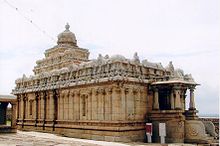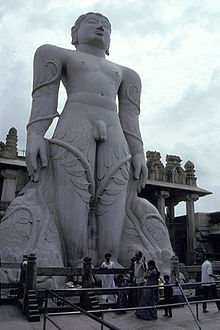- Chavundaraya
-
Chavundraya (Kannada: ಚಾಮುಂಡರಾಯ; ಚಾವುಂಡರಾಯ) (or Chamundaraya) (940–989) was a military commander, poet and a minister in the court of the Western Ganga Dynasty of Talakad (in present day Karnataka, India). A person of many talents, in 982 he commissioned the Gomateshwara, a monolithic sculpture in Shravanabelagola, an important place of pilgrimage for Jains. He was a devotee of the Jain Acharya Nemichandra and Ajitasena Bhattaraka and was an influential person during the reign of Kings Marasimha II, Rachamalla IV, and Rachamalla V (Rakkasa Ganga). A courageous commander with the title of Samara Parashurama, he found time to pursue his literary interests as well and became a renowned writer in Kannada and Sanskrit.[1][2] He wrote an important and existing prose piece called Chavundaraya Purana (also known as Trishasthi Lakshana Purana) in Kannada (978) and Charitrasara in Sanskrit. In his writing, he claims he was from the Brahmakshatriya Vamsa (Brahmin and converted to the Kshatriya caste).[3] He patronised the famous Kannada grammarians Gunavarma and Nagavarma I and the poet Ranna whose writing Parusharama Charite may have been a eulogy of his patron.[1] Because of his many lasting contributions, Chavundaraya is an important figure in the history of medieval Karnataka.
Contents
Commander
As a commander for the Western Ganga feudatory of the Rashtrakutas, he fought many battles for their Rashtrakutas overlords, beginning in the days of the Rashtrakuta king, Khottiga Amoghavarsha. In fact, the Gangas supported the cause of the Rashtrakutas till the very end.[4] During the last years of Rashtrakuta rule, the Gangas were also under constant threat of civil war and from invasions of the increasingly powerful Chola Dynasty. When a civil war broke out in 975, Chavundaraya supported the cause of Prince Rachamalla IV and installed him on the throne.[5]
An inscriptional eulogy of Chavundaraya on the Tyagada Brahmadeva pillar at Shravanabelagola (which has beautiful engravings representing Chavundaraya and his guru Nemichandra at the base) praises him thus,
“ A sun in the shape of a jewel adorning the crest of the eastern mountains, the brahmaksatra race; a moon in the shape of the splendour of his fame causing to swell the ocean, the brahmaksatra race; the central gem to the pearl necklace of Lakshmi, procured from the Rohana mountain, the brahmaksatra race.[6] ” The 10th century Algodu inscription of the Mysore district and the Arani inscription from the Mandya district provide more information on the family genealogy of Chavundaraya. It states that Chavundaraya was the grandson of Govindamayya who is praised for his knowledge and Dharma and was the son of Mabalayya, a subordinate of King Marasimha II. Mabalayya and his brother Isarayya are praised for their prowess in the inscription.[7] It is believed that their political position under King Marasimha II may have led to a gradual adoption of Kshatriya status by this Brahmin family.[8]
Writings
Inscribed handwriting (in Kannada characters) of Chavundaraya on Chandragiri hill in Shravanabelagola, Karnataka
Chavundaraya's writing, Chavundaraya Purana, is the second oldest existing work in prose style in Kannada and is a summary of the Sanskrit works, Adipurana and Uttarapurana, written by Jinasena and Gunabhadra during the rule of Rashtrakuta Amoghavarsha I. The prose work, composed in lucid Kannada, was meant mainly for the common man and avoided any reference to complicated elements of Jain doctrines and philosophy. In his writing, the influences of his predecessor Adikavi Pampa and contemporary Ranna are seen. The writing narrates the legends of twenty-four Jain Tirthankaras, twelve Chakravartis, nine Balabhadras , nine Narayanas and nine Pratinarayanas – narrations on sixty-three Jain proponents in all.[9][10]
Builder
The Gomateshwara monolith, a statue of the Jain saint, Gomateshwara, was commissioned by Chavundaraya and built on the Indragiri hill (also known as Vindhyagiri Hill) is a unique example of Western Ganga sculpture. Carved from fine-grained white granite, the image stands on a lotus. It has no support up to the thighs and is 60 feet tall with the face measuring 6.5 feet. With the serene expression on the face of the image, its curled hair with graceful locks, its proportional anatomy, the monolith size, and the combination of its artistry and craftsmanship have led it to be called the mightiest achievement in sculptural art in medieval Karnataka.[11] It is the largest monolithic statue in the world.[12] The Chavundaraya basadi also in Shravanabelagola and built on the Chandragiri Hill is credited to him by some scholars while others argue it was built by his son Jinadevana.[13] However by the 12th century additions to the shrine were made by a later King Gangaraja by which time tradition held that the shrine was built by Chavundaraya. However another view holds that the original shrine itself was consecrated in the 11th century and built in memory of Chavundaraya.[14]
Notes
- ^ a b Kamath (2001), p45
- ^ Sastri (1955), pp356-357
- ^ Kulkarni (1975) in Adiga (2006), p195
- ^ Kamath (2001), p84
- ^ Kamath (2001), p46
- ^ Gopal et al. (1973) in Adiga (2006), p196
- ^ Gopal et al. (1976) in Adiga (2006), p196
- ^ Adiga (2006), p196
- ^ Sastri (1955), p357
- ^ Kulkarni (1975) in Adiga (2006), p256
- ^ Dr. M Seshadri in Kamath (2001), p51
- ^ Keay, John (2000). India: A History. New York: Grove Press. p. 324 (across). ISBN 0802137970.
- ^ The characters on an inscription at the base of the image of Jain Tirthankara Parashwanatha in the basadi states a Jain temple was built by Jinadevana, Gopal et al. (1973) in Adiga (2006), p256
- ^ S. Settar in Adiga (2006), p256
References
- Sastri, Nilakanta K.A. (2002) [1955]. A history of South India from prehistoric times to the fall of Vijayanagar. New Delhi: Indian Branch, Oxford University Press. ISBN 0-19-560686-8.
- Kamath, Suryanath U. (2001) [1980]. A concise history of Karnataka : from pre-historic times to the present. Bangalore: Jupiter books. OCLC 7796041. LCCN 809-5179.
- Adiga, Malini (2006) [2006]. The Making of Southern Karnataka: Society, Polity and Culture in the early medieval period, AD 400-1030. Chennai: Orient Longman. ISBN 81 250 2912 5.
- Narasimhacharya, R (1988) [1988]. History of Kannada Literature. New Delhi, Madras: Asian Educational Services. ISBN 81-206-0303-6.
- Keay, John (2000) [2000]. History of India. New York: Grove publications. ISBN 0-8021-3797-0.
External links
- Chamundaraya and Shrvanabelagola
- Jaina Minsiter Chavundaraya by K. L. Kamat
Categories:- Indian Jains
- Indian monarchs
- People from Karnataka
- History of Karnataka
- Kannada writers
- 940 births
- 989 deaths
Wikimedia Foundation. 2010.




